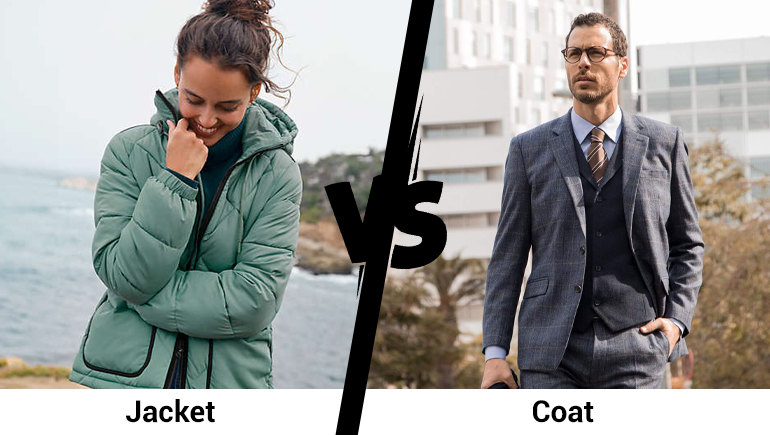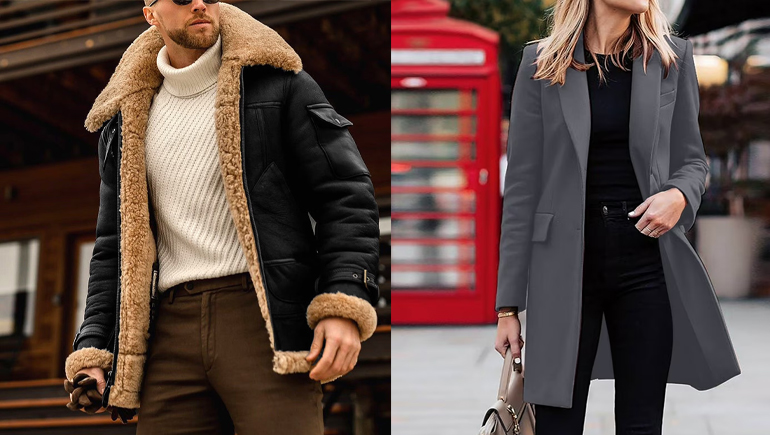
The right outerwear comes first in a snowy winter season. You’re standing in front of your closet on a chilly morning, reaching for that suitable layer. But is it a jacket you need? Or will a coat do?
You’re not alone, but understanding the principal distinctions is the secret to mastering style, comfort, and function in any season.
This definitive guide will simplify coats and jackets once and for all. We will list fundamental differences in length, insulation, fabric, and purpose so you can build a perfect outerwear wardrobe.
Let’s layer up!

A coat is a longer and heavier outer garment. It is designed to provide warmth and protection from cold weather. It contains a front opening and various fastenings. Typically, it extends below the hips. Men and women both wear it over other clothing.
It comes in various styles and is suitable for both formal and casual occasions. You can find it in different materials with some luxurious touches like ethical fur or chinchilla fur.
A jacket is a shorter and lighter layer than a coat. It can be worn indoors or outdoors. Jackets made by hand from smooth and comfortable fabrics are less insulating than coats. Some jackets offer warmth and protection. While some others, like denim jackets, serve as casual and stylish layers for moderate weather.

Also Read: 15 Types of Jackets for 2025: Your Guide to Style, Comfort & Features

Both sports coats and suit jackets are designed to be worn with trousers. Let's differentiate them.
A sports coat and jacket are standalone. It tends to have a more casual fit and includes details like corduroy jacket fabric or flannel jacket materials. You feel more comfortable when you wear it.
A suit jacket is a part of a matching suit (same fabric as pants). It's more formal and designed to match a pair of trousers for a complete suit. Its construction is more structured. This makes it more elegant for professional settings.
Both jackets and coats feature sleeves and a front closure. The purpose is the same: to cover your upper body. However, they differ in some ways.
| Features | Coat | Jacket |
| Length | Extends below the hips or longer | Hits at the waist or hips |
| Warmth | Heavy insulation | Light to moderate insulation |
| Weight | 14–20 oz/sq yd | 6–12 oz/sq yd |
| Season | Fall, winter, early spring | Spring and mild fall |
| Formality | More formal but includes casual styles | Covers everything from casual to smart-casual |
| Uses | Outer layer for cold | Outerwear or indoor layering |
| Fit | Looser cut to layer over other clothes | A closer and more tailored fit |
Let’s check out the major differences in outerwear from length to warmth.
Coats extend below the hips. They offer more coverage and insulation.
Jackets usually end at the waist or hip. They are lighter and more versatile for layering.
Coats use heavier fabrics like cashmere, chinchilla, or wool blends.
Jackets favor lighter materials such as corduroy, flannel, or leather. Perfect for transitional weather.
The outerwear can make a big impact as the seasons change. Here's a quick list to help you choose the perfect coat or jacket for every spell.

The ideal outerwear piece can enhance your entire look when you are layering up for winter. Let’s explore how to choose for every occasion.
The key difference between coats and jackets is length. That's actually the main point. Coats made from warmer materials are longer. They provide more coverage and better insulation. While Jackets are lighter and end at the waist. They are versatile for indoor and casual settings. Understand wisely: coats vs jackets. Just to build a wardrobe that works year-round.
For more options, check out our collection at Vel Clothing. Contact us via email at sales@velclothing.com.



